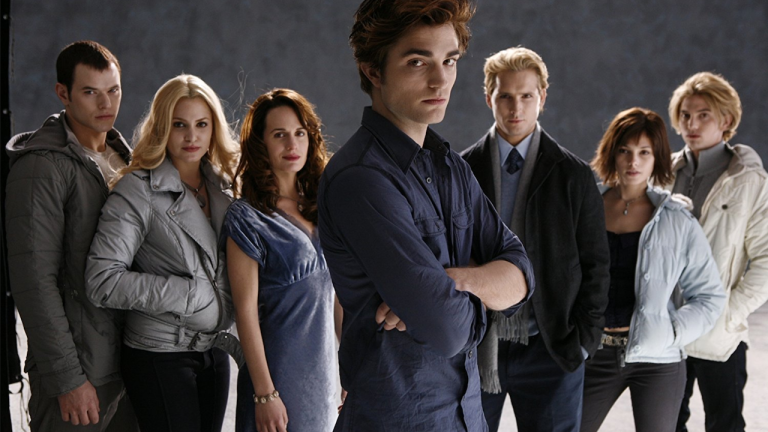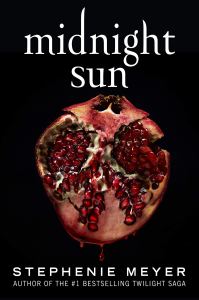How Midnight Sun Adds to Twilight Canon
From Alice’s visions to a Jacob cameo, how Midnight Sun illuminates new corners of the Twilight universe.

The following contains spoilers for Stephenie Meyer’s Midnight Sun.
As discussed in the review, by dint of being a retelling, Stephenie Meyer’s Midnight Sun doesn’t drastically change Twilight canon. (For that, check out Life and Death: Twilight Reimagined, Meyer’s gender-swapped rewrite of the first book that concludes with Beaufort Swan turning into a vampire to be with his immortal lady love Edythe Cullen.) However, it does expand our understanding of vampires through Edward’s perspective of his family: how each of the Cullens was turned, how they found each other, Edward’s personal struggle to follow Carlisle’s code of ethics, and how each Cullen interacts with Edward regarding Bella.
What Bella didn’t see in Twilight was how much Rosalie pushed back against Edward bringing a mortal into their family and tempting her to give up her humanity, and how Alice’s visions directly impacted his every move around Bella. In these Midnight Sun interactions, we also get a hint at Edward’s love life pre-Bella… or rather, his potential love life, as—surprise!—there’s not nearly as much as you would expect from a sexy vampire. Finally, Edward reveals more about his struggle with his vampire nature, and how he has made some peace with his bloody past.
Edward’s Talent and its Limits
One of the things that most draws Edward to Bella is that hers is the only mind that he can’t read, so he constantly feels off-balance around her. While he tells her as much in Twilight, in Midnight Sun he ponders what her parentage might have to do with it. It turns out that he also has difficulty parsing Charlie Swan’s thoughts; he can only get fleeting impressions or a few words here and there, as if there is a similar (though more permeable) shield. With Renée Dwyer, however, things are loud and clear—perhaps too loud, as Edward considers that even non-telepaths can probably at least intuit Renée’s thoughts and needs, the way that people seem naturally drawn to attend to her.
Alice’s Visions and Edward’s Dramatic Irony
The biggest “change” that Midnight Sun makes to the Twilight canon is the reveal that Edward knew almost from the beginning that Bella might one day become a vampire. Among the Cullen/Hale siblings, he and Alice are especially close due to their shared mental powers: As he can read her mind, that gives him a direct look into her visions. Concerning Bella, Alice sees a myriad of potential futures, but a few distinct paths stand out: Edward kills Bella. Edward leaves Bella, a blow to her emotional and physical well-being. Bella becomes a vampire.
The way Alice’s visions work is to first provide all potential futures, and then to quickly whittle down options, or clarify the major ones, through present actions. In real-time, through their arguments and debates over the Swan girl, Edward and Alice collaborate to figure out what is most likely to happen. While his taking Bella to the meadow eliminates the potential future in which he kills her—Edward has the attack of bloodlust that Alice predicted, but pushes through it—he can’t shake the likelihood that Bella will someday be a white-skinned, red-eyed, immortal creature.
This knowledge lends a dramatic irony to Midnight Sun, as Edward is constantly questioning whether his every action with Bella might tip the scales in one direction over the other. He, of course, does not share this dilemma with Bella, not wishing to encourage her toward the vampirism she claims to want. While Alice does let slip this vision by the end of the book, Edward struggles for as long as possible to give Bella as much free choice concerning her fate as he can.
With that in mind, Edward resolves by the end of Midnight Sun that he will live in the present in their relationship and resist the urge to peek at Alice’s visions:
I was taking our relationship one day at a time, one hour at a time. I didn’t look into the future. It was enough that I could feel it coming. When I promised her forever now, I meant as far as I could see. And I wasn’t looking.
But that’s simply a temporary solution to a permanent problem, and includes Edward trying to hide information both from Bella and himself. As he reflects to himself, he anticipates that something will happen to make him leave, and he doesn’t let Bella in on this fear. Instead, he tells her aloud that he will stay with her, then adds to himself:
As long as I can, as long as it’s allowed, as long as it doesn’t hurt you. Until the sign comes, until it’s impossible for me to ignore.
Which would seem to imply that he is not at all surprised at the events of New Moon, the “sign” to leave that he was already waiting for.
Edward’s Missing Week with Tanya and the Denali
After their bizarre first meeting in Twilight, Bella notices Edward’s absence from school for close to a week, before he reappears and saves her life in the parking lot. Midnight Sun reveals that Edward fled to Denali, Alaska, the Cullens’ former home and where their fellow vegetarian vampire coven still resides. It’s meant as a respite from Bella’s intoxicating scent, but it causes complications when vampire Tanya wonders if it means that Edward might have changed his mind about her romantic interest in him.
Alas for Tanya, despite her exquisite beauty, Edward has (amber) eyes for only one face. While they have a wistful conversation about how she wishes he would see her that way, ultimately Edward apologizes for “toying with [her] expectations” and actually draws inspiration from her relationships. After all, Tanya isn’t called a “succubus” for nothing; she’s had plenty of human lovers, many of whom lead long and healthy lives once Tanya learned to curb her bloodlust.
Though Bella eventually meets Tanya and the rest of the Denali coven in the later Twilight books, her cameo here fills in more of her one-sided romantic and sexual tension with Edward.
Cullen Family History
A lot of the Cullen family history comes out either during Twilight or certainly throughout the rest of the series, but because so much of Edward’s dilemma in Midnight Sun is about losing one’s humanity, he recalls how each of the Cullens and Hales joined the family.
To that end, the Cullens are unusual for having a family unit, as opposed to the more typical vampire coven. Covens might come together temporarily for a shared purpose and disband over disagreements, but a family is bound by deeper promises to one another: to lead a “vegetarian” lifestyle and maintain their treaty with the Quileutes by not draining human blood, but also to make decisions for the good of the family.
In contrast to how his telepathy makes him closer to Alice and her visions, Edward’s strained relationship with Rosalie gets explored more in Midnight Sun. As readers know, Carlisle turned her intending for Rosalie to be Edward’s mate, as Esme was for him, but despite her beauty, Edward wasn’t attracted to her. Instead, he saw her as a sister—at first in name, but then in action, the night she brought Emmett to the Cullens, near-death from a bear mauling, and begged Carlisle to change him to be her mate.
Despite this, they still clash over Edward’s choice of love in Midnight Sun—primarily because Rosalie is jealous of Bella. Left for dead by her ex-fiancé, immortality was the only option that Rosalie had, and she would give anything to have another chance at a human lifetime. So, Bella’s fervent desire to be turned feels to her like an utter waste. While these are sentiments that Rose expresses to Bella over the course of the Twilight series, Edward’s perspective delves deeper into his sympathy for Rosalie’s position, even if he resents her for not being willing to stick her neck out for Bella like the rest of the Cullens.
Edward’s Innocent/Guilty Victim
Edward understands Rosalie’s struggle with their vampire identity, and longing to be human, as he too has grappled with their bloodthirsty nature. As he tells Bella in Twilight, he had a bout of “rebellious adolescence” about ten years after becoming a vampire, in which he rejected Carlisle’s pacifism and left the family for a few years, to explore his baser instincts. Edward thought that because he could read humans’ minds, he could choose to kill only the guilty—rapists, murderers, moral monsters—and therefore “have it all” as a vampire with a conscience.
But while he admits as much to Bella, what he leaves unsaid is a big flashback upon which Midnight Sun expounds: September 1930, and his one victim who was technically innocent. In Milwaukee, Edward came upon a human man who was plagued with evil thoughts concerning a young girl in the tenement. Even as he repeated to himself, I can’t. I can’t. I can’t, he put together the resources and a plan to kidnap the young girl—the book doesn’t go graphically into his plan, but it’s easy to intuit that he intended to rape and murder her.
In the past, Edward had killed predators to ensure that they would not have a next victim; this time, he would be stopping a would-be monster before he took his first victim. Right as the man prepared to kidnap the girl, Edward captured him and killed him—serving the justice that the man had always subconsciously known he deserved.
In the end, Edward decided, even stopping humans from enacting evil on others was not enough to justify his killing them, and so he returned to Carlisle and the rest of his family.
Saving Bella
Readers get Edward’s side of the frantic chase after Bella and the tracker who lured her to a dance studio in Phoenix to kill her slowly in order to torture the Cullens—Edward, of course, but also Alice, his onetime victim who got away.
While Alice’s visions are the group’s lodestar for locating Bella before James kills her, Edward is so seized by vengeance that he could potentially alter their future to one of the scenarios where Bella dies. During their high-stakes chase scene in Phoenix, Jasper uses his talent of manipulating emotions to give Edward the empathic equivalent of a shot of novocaine: cold, numbing, and pushing aside pain so that he can focus on the job at hand.
Edward and Jacob
In contrast to his disdain for Mike Newton and the other human boys sniffing around Bella, Edward finds that he likes reading the mind of her friend Jacob Black: he considers the Quileute boy’s thoughts “engaging,” “pure and open,” and “restful.” Clearly he doesn’t see Jacob as a threat in Midnight Sun—at least, not at the beginning of the book. By the end, when Jacob cuts in to their dance at prom (to warn Bella that the Quileutes want her to break up with Edward and that they’ll “be watching” her and the Cullens), Edward notices with some surprise that the boy seems to have had a sudden growth spurt.
He also catches a curious thought from Jacob, about Bella having a weird perfume smell—something that Edward certainly didn’t notice. It’s all foreshadowing for Jacob’s werewolf transformation in New Moon, but it’s especially curious that Edward never catches on to the fact that his eventual rival for Bella’s heart is also a supernatural creature.
Persephone and the Pomegranate
The cover imagery for each side of the Twilight story provides some insight into the narrator’s impression of vampirism. For Bella, it’s an apple: the symbol of temptation, yes, but also of knowledge. A pair of hands hold the apple out, as if they have plucked it from the tree but haven’t yet worked up the nerve to take a bite. Bella’s journey in Twilight is taking that irreversible step toward knowing, because once she does, she won’t want anything else.

Where Bella sees potential, Edward sees consequence: Midnight Sun replaces the apple with a pomegranate that has already been split in two. Throughout the novel, he likens Bella to innocent Persephone, who eats half the pomegranate seeds and curses herself to spend half her life in the underworld with Hades, her (depending on the telling) lover and/or captor. Spurred on by the knowledge, via Alice’s vision, that there is a very possible future in which Bella becomes a vampire, Edward cannot stop obsessing over this metaphor and how, he believes, it would rob Bella of the joys of mortal life.
The Meaning of “Midnight Sun”
The first time that Edward realizes Bella is dreaming of him, and it’s not a nightmare, it challenges his self-perception the way nothing or no one else has in his near-century of life. He reflects:
My life was an unending, unchanging midnight. It must, by necessity, always be midnight for me. So how was it possible that the sun was rising now, in the middle of my midnight?
It… reads like pretty bad teenage love poetry, but what he’s trying to say is that when he was turned, every part of him was frozen, including his sense of self and his desires. As the sun permeating his midnight, Bella is making him reexamine what he’s allowed to want.
It’s not quite as poignant as the meaning behind Twilight: “It’s the safest time of day,” he explains to Bella. “The easiest time. But also the saddest, in a way… the end of another day, the return of the night.” But perhaps, as he seems to realize, if he pushes through to the deepest part of night, he’ll find a bright light to illuminate new parts of it he hadn’t noticed before.
